
Did Dinosaurs Evolve into Birds?
Did dinosaurs evolve into birds? And are the birds we see at our window actually feathered dinosaurs? For many evolutionists these claims are unassailable facts. But how good is the scientific evidence that birds are related to dinosaurs and is such an idea consistent with what the Bible tells us about birds and their Creation?
The Bible on Birds
The Bible mentions birds over 300 times in references ranging from Genesis to Revelation. The Hebrews showed a keen knowledge of the birds familiar to them and gave many of them Hebrew names. These names are difficult to translate, but many modern birds can be recognized from their Biblical description. The Old Testament uses several terms for birds in general such as the Hebrew word ‘oph which can refer to flying insects and bats as well as birds. It is this term that is translated several times as “birds” in the Creation account in Genesis chapters one and two. Here we learn that the birds and other flying creatures, as well as all water-dwelling creatures, were created on the fifth day of the Creation week.
Critical Thinking
When discussing this issue, it is important not to simply take every claim at face value. Creationists rarely have direct access to the so-called “avian dinosaur” fossils and are often left studying photos, claims and datasets produced by evolutionists. We must avoid uncritically accepting evolutionary data and interpretation without considering the implications of observer bias. Fossil finds and the claims advanced must be carefully examined to ensure it is being presented accurately. Not all differences and similarities between birds and dinosaurs are of equal value in distinguishing them from one another. With that in mind, in order to understand what makes dinosaurs and birds different, we need to look at their anatomy and physiology. Birds and dinosaurs have vastly different anatomies that go well beyond mere feathers. While feathers are an important feature, they are not the only distinctive feature that separates birds from dinosaurs. Much of the bird’s internal anatomy is vastly different from dinosaur anatomy.
What's So Special About Birds?
Is there anything unique about birds that allows us to clearly distinguish them from all other creatures including dinosaurs? For many years the most obvious answer would have been feathers, but that began to change in 1861 when a fossilized feather was discovered in the “150 million-year-old” late Jurassic strata in Bavaria. This feather, which was classified as Archaeopteryx (ancient wing), was essentially identical to the feathers of modern birds. A few years later a feathered fossilized skeleton of Archaeopteryx was discovered and was described by Richard Owen in 1863. Owen was an influential naturalist who coined the word dinosaur and was the first to recognize them as a distinct taxonomic group. Owen declared Archaeopteryx to be “unequivocally a bird.”1
While most ornithologists have considered Archaeopteryx to be a bird with a lesser degree of bone fusion than is seen in most modern birds, dinosaur experts have generally considered it to be a feathered dinosaur. The whole question has become further confused by the prevailing view among evolutionists that birds are in fact dinosaurs, belonging to a suborder of dinosaurs called Theropoda (meaning “beast footed”). The Theropods are a diverse group ranging in size from that of a cat up to a 9-ton Tyrannosaurus. Theropods are similar to birds in that they are bipedal (walk on two legs) and are claimed to have “hollow bones.” However there are significant differences between theropods and birds.
Warm Blooded vs. Cold Blooded
Vertebrates that regulate their body temperature within a narrow range, independent of external temperatures, are called homeothermic (warm-blooded). Birds are homeothermic having a normal temperature between 106℉ and 110℉, higher than most mammals. There are no living homeothermic reptiles, but many evolutionists believe that dinosaurs were warm-blooded (or mesothermic). The evidence for this is less than compelling. The microscopic structure (histology) of dinosaur bone is often cited as empirical evidence for warm-blooded dinosaurs, but this is at best inconclusive. Bone histology varies during the life of a vertebrate and does not always correlate with homeothermy.
There is one skeletal feature that could help determine if a dinosaur were warm-blooded. Warm-blooded creatures have scroll-like bones in their nose called nasal conchae (turbinates). These are thin plates of bone covered with a well-vascularized mucosa that warms and humidifies the inspired air. Most, if not all, birds have these structures2 along with other warm-blooded creatures, while dinosaurs appear to lack nasal conchae.3 This would be consistent with dinosaurs being cold-blooded like all other living reptiles.4
The Unique Avian Respiratory System
The structure of the avian lung is unique among all vertebrates and, though relatively small in size, is the most efficient vertebrate lung. Birds do not have tidal respiration, like mammals and reptiles, where air is alternately moved in and out of the lung. Instead, airflow in the avian lung is continuous and unidirectional. Birds do not exchange oxygen and carbon dioxide in blind-ending alveoli like the alveolar lungs of mammals and reptiles, but rather they exchange gasses in flow-through tubular structures called parabronchi. Air is moved in and out of the lungs through pressure changes in nine air sacs located throughout the body. The air sacs function like a bellows to move air through the lungs.
One of the most unique things about the avian respiratory system is that birds do not have a diaphragm, which is the primary muscle mammals and walking reptiles use to breathe. Instead, the air sacs are squeezed and expanded by numerous muscles acting on the sternum and hinged ribs unique to birds.
Lungs and diaphragms are soft tissues and thus are only infrequently fossilized. But fossil evidence suggests that theropod dinosaurs, which are believed to be bird ancestors, had lungs that were much like living crocodiles and alligators.5
Bird Wings
Nearly all birds, with the exception of a few extinct varieties, have wings. Wings may be specially suited for flapping, gliding, swimming, or balance when running. In flapping flight, a bird needs powerful muscles to move its wings both up and down. The largest muscles in the bird are the breast muscles involved in moving the wings during flight. These muscles can comprise up to nearly a third of the bird’s body weight. The powerful pectoralis muscles bring the wings down in flapping flight. But muscles can only pull by contraction, they cannot push. This raises the question of how the bird powerfully elevates its wing during flapping flight. This problem is solved by the large supracoracoideus muscle, located in the chest under the pectoralis muscle. This muscle elevates the wing using a tendon that passes through a unique pully-like structure in the bird’s shoulder called the triosseal canal and attaches to the humerus. Thus, the tendon of the supracoracoideus acts to raise the wing just like pulling down on a halyard on a sailboat raises the sail. In most flying birds, the powerful pectoralis and supracoracoideus muscles attach to a unique keeled sternum.
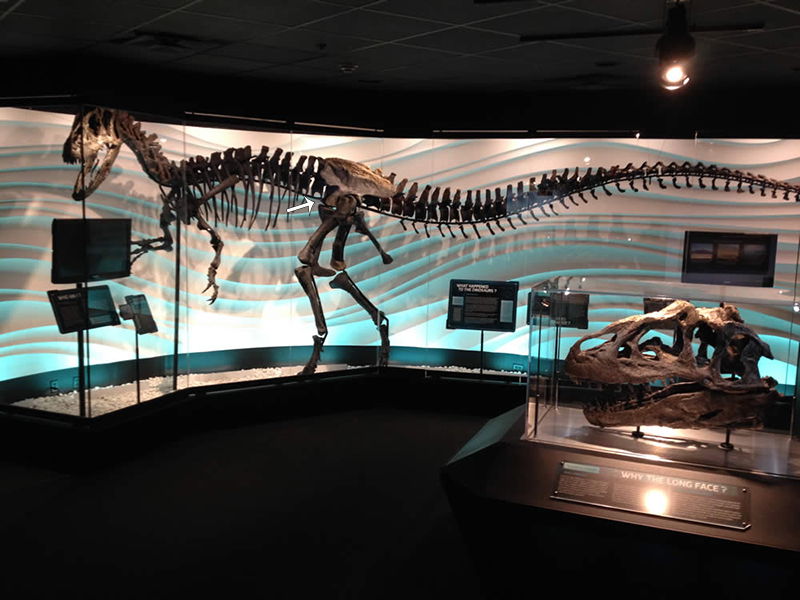
Image credit: Creation Museum, Petersburg, Kentucky, USA.
Figure 1.1. Our "Ebeneezer" Allosaurus skeleton. Note the balance point at the hip indicated by the white arrow.
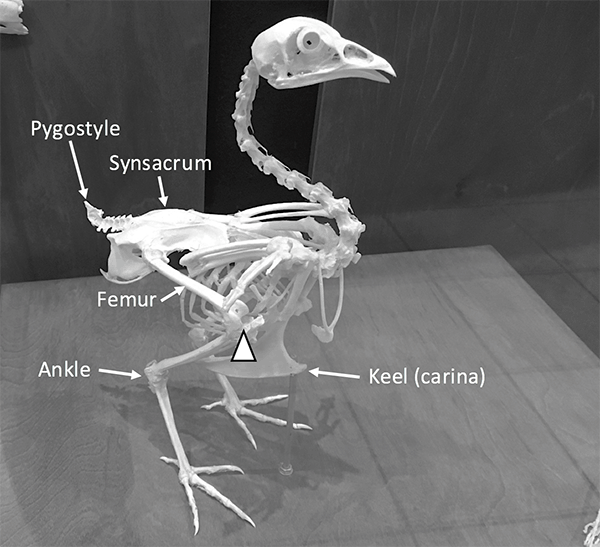
Image credit: Creation Museum, Petersburg, Kentucky, USA.
Figure 1.2. Chicken skeleton. Notice the balance point is forward at the knee.
Bird Legs
Do birds have knees? About half way down a bird’s leg there is a bend that might be a knee, except that it bends the wrong way (figure one). This is not the bird’s knee but rather the bird’s ankle. Thus, from this bend to the tip of the toes is the bird’s foot. And from this bend to the bird’s body is that part of the leg (“drum stick”) that extends from the ankle to the knee. So, the knee is not visible in an intact bird because it is inside the bird’s body. This means that all of the bird’s femur (the thigh bone) with its associated muscles are inside the bird’s body as well! As a result, birds walk from their knees on down rather than from their hips. There is no other vertebrate quite like this—including true dinosaurs (see figure one).
It's All About Balance
What possible advantage could it be for a bird to have fully flexed femurs entirely inside its body cavity? The obvious advantage of this arrangement is balance. If a creature walks on two legs, as opposed to four, the body must be balanced differently. The balance point for bipedal dinosaurs is the head of their femur where it articulates with the hip bones of the pelvis. Since bipedal dinosaurs held their heavy muscular tail off the ground, the tail behind the hip counterbalanced the body in front of the hip. So, whatever else bipedal dinosaurs used their tail for, its most essential function must have been balance.
In contrast to bipedal dinosaurs, living birds and most fossil birds have very short tails (not counting the tail feathers) with both movable and fused vertebrae forming a short tail called the pygostyle. In the case of birds, there is very little weight behind the head of the femur where it articulates with a pelvic structure called the synsacrum. The synsacrum is composed of 10–24 fused, lightweight bones and appears to be unique to birds (see figure one). If a bird tried to walk from the hip like bipedal dinosaurs, it would fall forward on its beak. This is prevented by the highly flexed orientation of the femurs that brings the knees of the bird up and well forward of the head of the femur. Thus, in birds the point of balance is the knee rather than the hip. It follows then that it should be possible to tell if a fossil is a bird or bipedal dinosaur by observing where the balance point would have to be—at the hip or at the knee (see figure one).
Bony Bird Tails vs. Bony Dinosaur Tails
Today, all birds have a short tail consisting of four to nine non-fused caudal vertebrae (see figure one). Some extinct birds like Archaeopteryx had a long, bony tail that has led to their misidentification as dinosaurs. But there is a clear difference between the bony tails of fossil birds and those of bipedal dinosaurs. Theropod dinosaurs had muscular tails much like an alligator. This is evident from the fact that the tail vertebrae of such dinosaurs have bony projections that served as attachments and levers for the powerful tail muscles. On the dorsal side of the vertebrae are neural spines and on the ventral side are haemal spines (chevrons). These are necessary for muscular attachment, permitting the tail to act as a counterweight.
By contrast fossil bird tail vertebrae are much less robust than those of dinosaurs and, except for the base of the tail, lack bony attachments for muscles such as dorsal and haemal spines. Indeed, there is evidence that the feathers of the long, bony bird tail anchored directly on the vertebrae much like flight feathers attach by means of ligaments to the wing bones in modern birds. This suggests that the long, bony tails of fossil birds had very little if any muscle and would have acted like a flexible spring pole with attached feathers. So, whether birds had long, bony tails like some extinct birds or lacked long, bony tails like modern birds, the bird tail is too lightweight to counterbalance the body from the hip in the manner of bipedal dinosaurs.
Did True Dinosaurs Have Feathers?
At least five families of theropod dinosaurs are claimed to have true pennaceous feathers like modern birds. However, critical evaluation of each fossil is necessary in order to determine if evolutionary claims are accurate. Unfortunately, many dinosaur finds are claimed to have feathers when no pennaceous feathers are found. One such example is in the theropod Ornithomimosaurid group. Some fossil specimens only show marks on bony surfaces thought to be attachment points for feathers and detached filaments, while others show pennaceous feathers.6 Note, however, that there are conflicts in the classification, even in the same species. One such example is Ornithomimus edmontonicus, shown in figure two. The two fossils are classified as the same species. However, anatomically, the two are clearly not the same creature. Notice the tails are vastly different between the two creatures, and the head sizes are different. This illustrates just how messy the classification of dinosaurs has become. It is likely that the one with the obvious haemal and neural spines is a reptile, while the one with a relatively short, spindly tail is a true bird. This puts these two members of the same “species” in separate orders. This is the problem created by artificially trying to create relationships between dinosaurs and birds. The classification system becomes murky and confused.
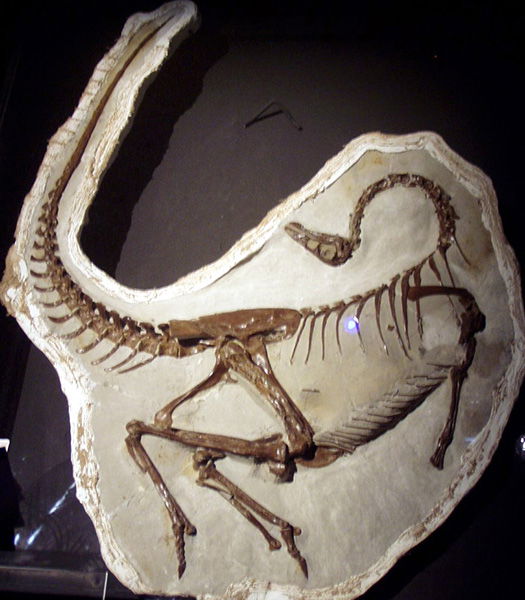
Image via Sebastian Bergmann, Wikimedia Commons.
Figure 2.1. Reptilian Ornithomimus edmontonicus skeleton. Notice the extensive haemal and neural spines on the tail and the shape of the head.
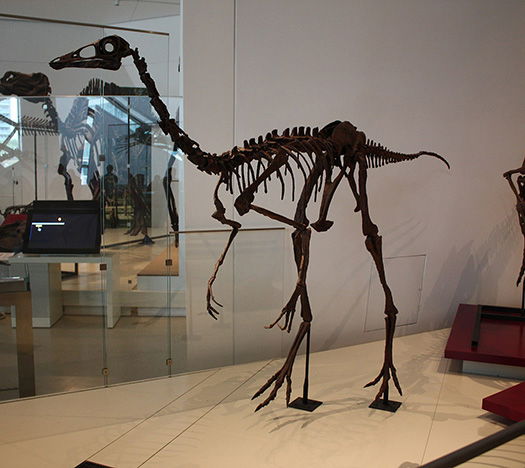
Image via IJReid, Wikipedia Commons.
Figure 2.2. Avian Ornithomimus edmontonicus skeleton. Notice that haemal and neural spines are present only at the base of the tail, what is likely the pygostyle. Also notice the differing head shape.
These issues are persistent across most of the “theropod” families (or clades) that are claimed to have had feathers, which include Trooidontidae, Oviraptosauria, and Dromaeosauridae. Many members of these families do indeed have well-developed pennaceous feathers, but in each case the fossils appear to be birds and not dinosaurs. Trooidontidae is a very confusing family made of largely unknown and fragmentary species. The beak of Oviraptors is toothless like all modern birds, and some fossils have been found in what appears to be a nesting position on eggs.7 They also had a pygostyle and rib structure similar to birds. Many Dromaeosaurs have characteristics of birds such as being covered in pennaceous feathers, including large, aerodynamic wing feathers. They had long arms (wings) that could be folded against the body, and their tails were long with bony vertebrae lacking dorsal and haemal spines except at the base of the tail.8 Such a tail contrasts sharply with the tails of true theropod dinosaurs that are heavily muscled with haemal and neural spines.9 If one examines a fossil of a complete Dromaeosaur skeleton such as Zhenyuanlong, it is clear that, to balance, they would need to have walked from the knee like modern birds, rather than from the hip like theropod dinosaurs (see figure 3 below).
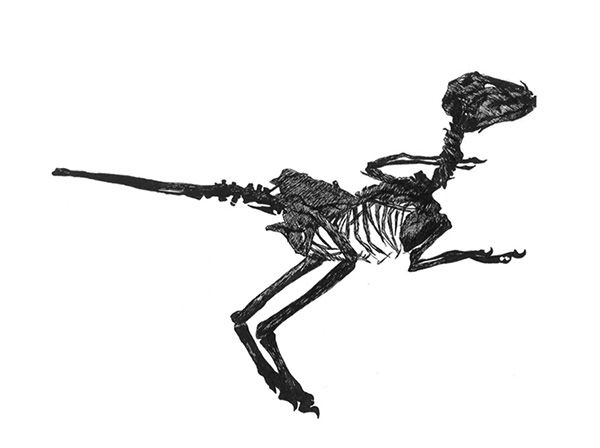
Image credit: Hannah Ahern, Answers in Genesis.
Figure 3.1. Zhenyuanlong suni positioned as a bird with fulcrum at the knee.
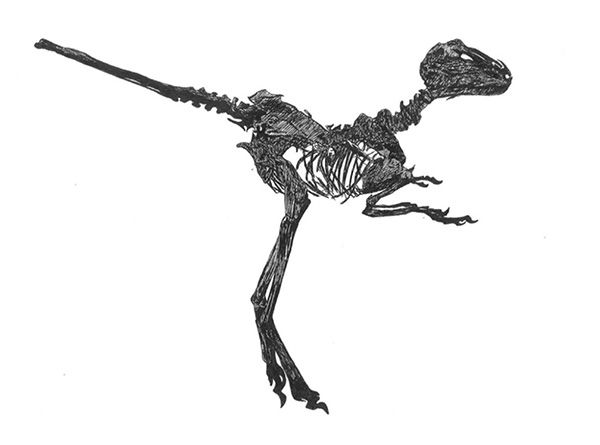
Image credit: Hannah Ahern, Answers in Genesis.
Figure 3.2. Zhenyuanlong suni positioned as a dinosaur with fulcrum at the hip. Notice how top heavy it appears.
The clade of “theropod dinosaurs” known as Avialae clearly have pennaceous feathers, but this shouldn’t come as a surprise because the Avialae are in fact birds. All living birds, for example, would be considered members of Avialae, but avialans have also been found as fossils in the late Jurassic Tiaojishan strata of China that evolutionists claim to be about 160 million years old.10 This is as old or older than most of the theropod nonavian dinosaurs that are believed to be evolutionary ancestors of birds.
A Word of Caution
Many of the fossils that headline the “feathered dinosaur world” come out of the Liaoning Province of China. As paleontologists poured into the area, local farmers began to realize the value of the fossils they had been throwing away, and a large fossil black market sprang up. This fossil market culminated to a massive black eye in 1999 for National Geographic when they published an article proclaiming that a new fossil called Archaeoraptor was the missing link between theropods and birds. However, Archaeoraptor was a fraud, made of no less than three separate creatures.11 Part of the problem is that scientists often buy these Chinese fossils rather than dig them out of the ground, and some of these fossils can be forged. Luis Chiappe, an expert on fossil birds who has described multiple fossil species, told Science in 2013 that “High quality forgeries can fool paleontologists just as easily as forgeries in the art community.”12. Often it is not revealed in the scientific paper if the fossil was bought or dug from the ground. Even when it is revealed, there are still potential problems. The researchers studying the birdlike Dromaeosaur Changyuraptor attempted to authenticate their fossil, which they purchased, and discovered “an attempt to artificially reconstruct the neck.”13 Clearly fossil forgery is a problem in China, even on legitimate fossils.
Conclusion
Birds have many distinctive features that distinguish them from dinosaurs. They are homeothermic with a high metabolic rate and high body core temperature. Their unique, high-efficiency, flow-through respiratory system, with no diaphragm muscle and numerous large air sacs distributed throughout their body that open into pneumatic bones, are also distinctive. Birds have a high degree of bone fusion with lightweight bones supported from within by numerous bony struts. They have a unique synsacrum structure and highly flexed thighs that are located inside their body, bringing their balance fulcrum forward to their internal knee. As a result, birds balance and walk from the knee, not the hip as the bipedal dinosaurs did. Finally, feathers appear to be as unique to birds as hairs are to mammals. Fossilized impressions of dinosaur skin resemble the skin of an alligator, not feathers on birds. Based on current evidence, there is no compelling reason to believe that true dinosaurs had feathers, or that they were related to birds.
Footnotes
- Shipman, Pat. Taking wing: Archaeopteryx and the evolution of bird flight. New York: Simon and Schuster, 1998.
- Geist, Nicholas R. “Nasal Respiratory Turbinate Function in Birds.” Physiological and Biochemical Zoology Volume 73, No 5. (2000): 581–589. https://doi.org/10.1086/317750.
- Ruben, John A. And Willem J. Hillenius “The Evolution of Endothermy in Terrestrial Vertebrates: Who? When? Why?” Physiological and Biochemical Zoology 77, no. 6 (2004): 1019–1042. https://doi.org/10.1086/425185.
- Ibid.
- Ruben, John A. Terry D. Jones, Nicholas R. Geist, and W. Jaap Hillenius “Lung Structure and Ventilation in Theropod Dinosaurs and Early Birds.” Science 278, Issue 5341 (1999): 1267–1270. https://doi.org/10.1126/science.278.5341.1267.
- Zelenitsky, Darla K. Francois Therrien, Gregory M. Erickson, Christopher L. DeBuhr, Yoshitsugu Kobayashi, David A. Eberth, and Frank Hadfield. “Feathered Non-Avian Dinosaurs From North America Provide Insight into Wing Origins.” Science 338 Issue 6106 (2014): 510–514. http://science.sciencemag.org/content/338/6106/510.
- Dong, Zhi-Ming and Philip J. Curie. “On the discovery of an oviraptorid skeleton on a nest of eggs at Bayan Mandahu, Inner Mongolia, People’s Republic of China.” Canadian Journal of Earth Sciences 33 Issue 4 (1996): 631–636. https://doi.org/10.1139/e96-046.
- Hwang, Sunny H. Mark A. Norell, Ji Qiang, and Gao Keqin. “New Speciments of Microraptor zhaoianus (Therepoda: Dromaeosauridae) from Northeastern China.” American Museum Novitates Number 3381 (2002). https://www.researchgate.net/publication/232692710_New_Specimens_of_Microraptor_zhaoianus_Theropoda_Dromaeosauridae_from_Northeastern_China.
- Pol, Diego. And Oliver W. M. Rauhut. “A Middle Jurassic abelisaurid from Patagonia and the early diversification of theropod dinosaurs.” Proceedings of the Royal Society B 279, Issue 1741 (2012): 3170–3175. http://rspb.royalsocietypublishing.org/content/279/1741/3170.
- Liu Y.-Q. H. W. Kuang, X.-J. Jiang, N. Peng, H. Xu, and H. Y. Sun."Timing of the earliest known feathered dinosaurs and transitional pterosaurs older than the Jehol Biota".Palaeogeography, Palaeoclimatology, Palaeoecology. 323–325 (2012):1–12. DOI:10.1016/j.palaeo.2012.01.017.
- Rowe, Timothy. Richard Ketchum, Cambria Denison, Matthew Colbert, Xing Xu and Philip J. Currie. “Forensic paleontology: The Archaeoraptor forgery.” Nature 410 (2001): 539–540. https://www.nature.com/articles/35069145.
- Balter, Michael. “Authenticity of China’s Fabulous Fossils Gets New Scrutiny.” Science 340 (2013): 1153–1154. DOI: 10.1126/science.340.6137.1153.
- Han, Gang. Luis M. Chiappe, Shu-An Ji, Michael Habib, Alan H. Turner, Anusuya Chinsamy, Xueling Liu, and Lizhuo Han. “A new raptorial dinosaur with exceptionally long feathering provides insights into dromaeosaurid flight performance.” Nature Communications July 15, 2014. Accessed August 23, 2018. https://www.nature.com/articles/ncomms5382.
Recommended Resources

Answers in Genesis is an apologetics ministry, dedicated to helping Christians defend their faith and proclaim the good news of Jesus Christ.
- Customer Service 800.778.3390
- Available Monday–Friday | 9 AM–5 PM ET
- © 2025 Answers in Genesis


